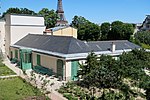Grand Auditorium (Maison de la Radio)
Radio France Auditorium is an arena shape concert hall with an organ dedicated to the performance of classical music. Built as part of a major restoration work of the Paris headquarter of French national radio broadcasting organization Radio France, it is located in the 16th arrondissement of Paris in the heart of the city. The Auditorium was designed to serve as the residence of the four musical ensembles of the organization : Orchestre National de France, Orchestre Philharmonique de Radio France, Chœur de Radio France and Maîtrise de Radio France. Fully equipped with audiovisual equipment, the concert hall is also a recording and broadcasting studio and a screening room. The Auditorium is also devoted to Radio France seven national networks : France Inter, France Info, France Culture, France Musique, FIP, France Bleu, Mouv'.
Excerpt from the Wikipedia article Grand Auditorium (Maison de la Radio) (License: CC BY-SA 3.0, Authors).Grand Auditorium (Maison de la Radio)
Avenue du Président Kennedy, Paris 16th Arrondissement (Paris)
Geographical coordinates (GPS) Address Phone number Website Nearby Places Show on map
Geographical coordinates (GPS)
| Latitude | Longitude |
|---|---|
| N 48.8526 ° | E 2.2782 ° |
Address
Radio France - Maison de la Radio
Avenue du Président Kennedy 116
75220 Paris, 16th Arrondissement (Paris)
Ile-de-France, France
Open on Google Maps









